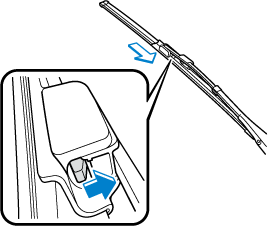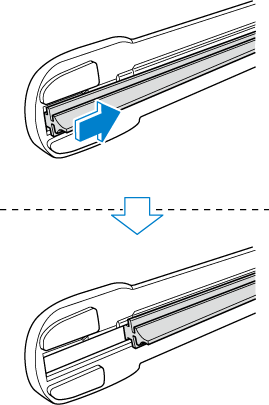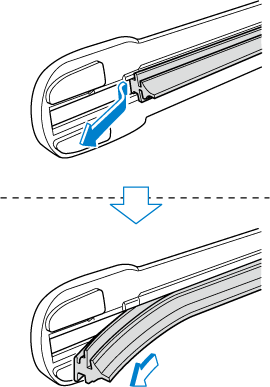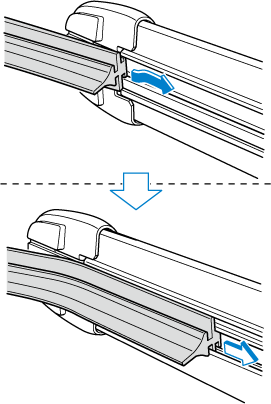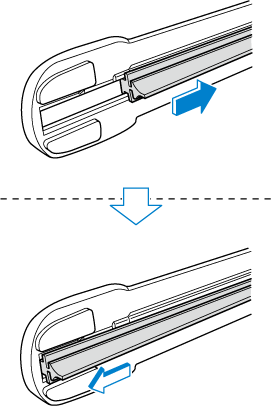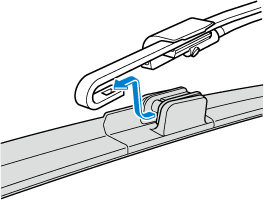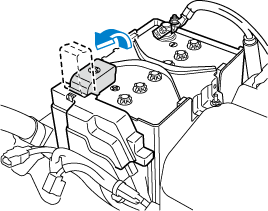Owner Maintenance
Owner Maintenance Precautions
Hood
Always check that the hood is closed and securely locked:
A hood that is not closed and securely locked is dangerous as it could fly open while the vehicle is moving and block the driver's vision which could result in a serious accident.
Opening the Hood
-
With the vehicle parked, pull the release handle to unlock the hood.
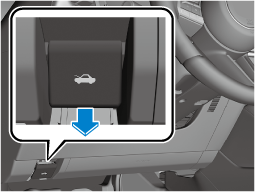
-
Insert your hand into the hood opening, slide the latch lever in the direction of the arrow as shown in the illustration, and lift up the hood.
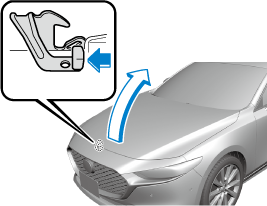
-
Grasp the support rod in the padded area and secure it in the support rod hole indicated by the arrow to hold the hood open.
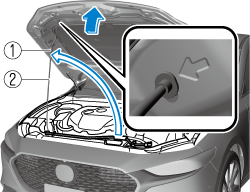
-
Pad
-
Support rod
-
Closing the Hood
-
Check under the hood area to make certain all filler caps are in place and all loose items (e.g. tools, oil containers, etc.) have been removed.
-
Lift the hood, grasp the padded area on the support rod, and secure the support rod in the clip. Verify that the support rod is secured in the clip before closing the hood.
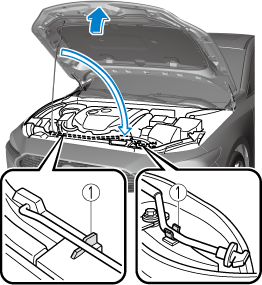
-
Clip
-
-
Lower the hood slowly to a height of about 20 cm (7.9 in) above its closed position and then let it drop.
When closing the hood, do not push it excessively such as by applying your weight. Otherwise, the hood could be deformed.
Engine Compartment Overview
SKYACTIV-G 2.0 and SKYACTIV-G 2.5
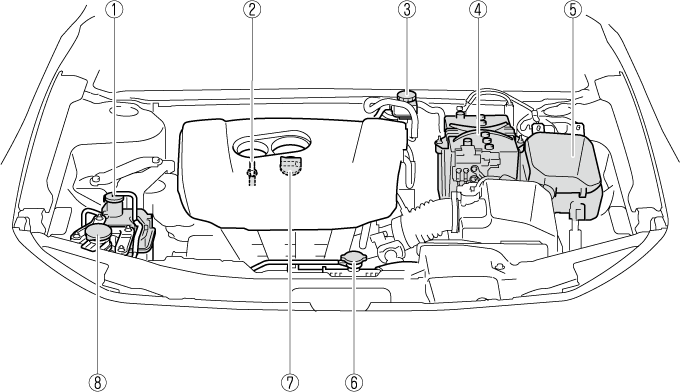
-
Engine coolant reservoir
-
Engine oil dipstick
-
Brake/Clutch fluid reservoir
-
Battery
-
Fuse block
-
Cooling system cap
-
Engine oil-filler cap
-
Windshield washer fluid reservoir
SKYACTIV-G 2.5T
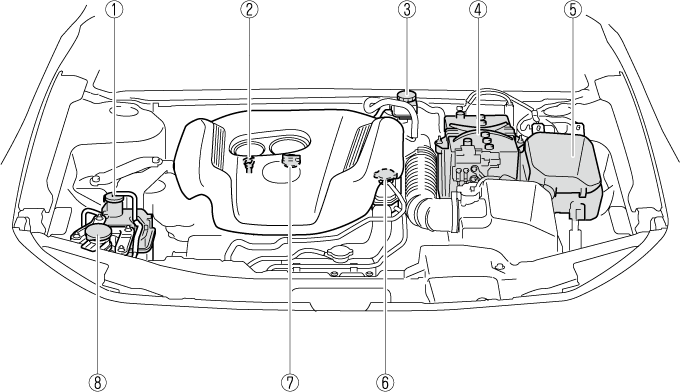
-
Engine coolant reservoir
-
Engine oil dipstick
-
Brake fluid reservoir
-
Battery
-
Fuse block
-
Cooling system cap
-
Engine oil-filler cap
-
Windshield washer fluid reservoir
Recommended Oil
U.S.A., Canada
SKYACTIV-G 2.0 and SKYACTIV-G 2.5
Use ILSAC GF-V or higher/ SAE 0W-20 engine oil.
Mazda Genuine Oil is used in your Mazda vehicle. Mazda Genuine 0W-20 Oil is required to achieve optimum fuel economy.
For maintenance service, Mazda recommends Genuine Mazda Parts and Genuine Mazda Premium Oil.
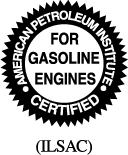
Only use SAE 0W-20 oil “Certified For Gasoline Engines” by the American Petroleum Institute (API).
Oil with this trademark symbol conforms to the current engine and emission system protection standards and fuel economy requirements of the International Lubricant Standardization and Approval Committee (ILSAC), comprised of U.S. and Japanese automobile manufacturers.
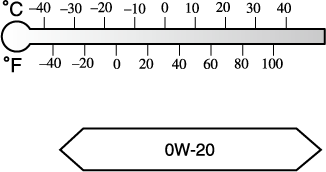
SKYACTIV-G 2.5T
Use SAE 5W-30 engine oil.
Mazda Genuine Oil is used in your Mazda vehicle. Mazda Genuine 5W-30 Oil is required to achieve optimum fuel economy.
For maintenance service, Mazda recommends Genuine Mazda Parts and Genuine Mazda Premium Oil.

Only use SAE 5W-30 oil “Certified For Gasoline Engines” by the American Petroleum Institute (API).
Oil with this trademark symbol conforms to the current engine and emission system protection standards and fuel economy requirements of the International Lubricant Standardization and Approval Committee (ILSAC), comprised of U.S. and Japanese automobile manufacturers.
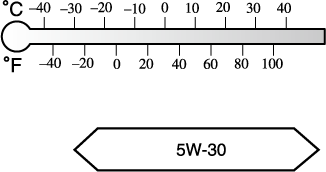
Except U.S.A., Canada
Use SAE 5W-30 engine oil.
Oil container labels provide important information.
A chief contribution this type of oil makes to fuel economy is reducing the amount of fuel necessary to overcome engine friction.
For maintenance service, Mazda recommends Mazda Genuine Parts.
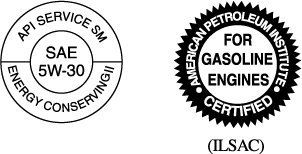
(Mexico)
SKYACTIV-G 2.0 and SKYACTIV-G 2.5
Use API SM or higher, or ILSAC GF-IV or higher/SAE 5W-30 engine oil. If SAE 5W-30 engine oil is not available, use SAE 5W-20 engine oil.
The quality designation SM, SN or SP, or ILSAC must be on the label.

SKYACTIV-G 2.5T
Use API SM or higher, or ILSAC GF-IV or higher/SAE 5W-30 engine oil. If SAE 5W-30 engine oil is not available, use SAE 0W-30 or SAE 10W-30 engine oil.
The quality designation SM, SN or SP, or ILSAC must be on the label.
Inspecting Engine Oil Level
-
If the engine oil level warning indication/warning light turns on, add 1 L (0.26 US gal, 0.22 Imp gal) of engine oil.
-
Be sure the vehicle is on a level surface.
-
Warm up the engine to normal operating temperature.
-
Turn it off and wait at least 5 minutes for the oil to return to the oil pan.
-
Pull out the dipstick, wipe it clean, and reinsert it fully.

-
MAX
-
OK
-
MIN
-
-
Pull it out again and examine the level.
The level is normal if it is between the MIN and MAX marks.
If it is near or below MIN, add enough oil to bring the level to MAX.
-
Make sure the O-ring on the dipstick is positioned properly before reinserting the dipstick.
-
Reinsert the dipstick fully.
Washer Fluid
Inspecting Washer Fluid Level
Use only windshield washer fluid or plain water in the reservoir:
Using radiator antifreeze as washer fluid is dangerous. If sprayed on the windshield, it will dirty the windshield, affect your visibility, and could result in an accident.
Using Washer Fluid Without Anti-freeze Protection in Cold Weather:
Operating your vehicle in temperatures below 4 °C (40 °F) using washer fluid without anti-freeze protection is dangerous as it could cause impaired windshield vision and result in an accident. In cold weather, always use washer fluid with anti-freeze protection.
State or local regulations may restrict the use of volatile organic compounds (VOCs), which are commonly used as anti-freeze agents in washer fluid. A washer fluid with limited VOC content should be used only if it provides adequate freeze resistance for all regions and climates in which the vehicle will be operated.
Add washer fluid under any of the following conditions.
-
The top of the fluid level is low.
-
The Low Washer Fluid Level Warning Indication/Warning Light (if equipped) turns on.
-
The top of the fluid level is lower than E (if equipped).

Use plain water if washer fluid is unavailable.
But use only washer fluid in cold weather to prevent it from freezing.
Wiper Blades
Replacing Windshield Wiper Blades
Battery
Battery
Wash hands after handling the battery and related accessories:
Battery posts, terminals and related accessories contain lead and lead compounds, chemicals known to the State of California to cause cancer and reproductive harm.
 Read the following precautions carefully before using the battery or inspecting to ensure safe and correct handling:
Read the following precautions carefully before using the battery or inspecting to ensure safe and correct handling:
 Always wear eye protection when working near the battery:
Always wear eye protection when working near the battery:
Working without eye protection is dangerous. Battery fluid contains SULFURIC ACID which could cause blindness if splashed into your eyes. Also, hydrogen gas produced during normal battery operation, could ignite and cause the battery to explode.
 Wear eye protection and protective gloves to prevent contact with battery fluid:
Wear eye protection and protective gloves to prevent contact with battery fluid:
Spilled battery fluid is dangerous.
Battery fluid contains SULFURIC ACID which could cause serious injuries if it gets in eyes, or on the skin or clothing. If this happens, immediately flush your eyes with water for 15 minutes or wash your skin thoroughly and get medical attention.
 Always keep batteries out of the reach of children:
Always keep batteries out of the reach of children:
Allowing children to play near batteries is dangerous. Battery fluid could cause serious injuries if it gets in the eyes or on the skin.
 Keep flames and sparks away from open battery cells and do not allow metal tools to contact the positive (+) or negative (-) terminal of the battery when working near a battery. Do not allow the positive (+) terminal to contact the vehicle body:
Keep flames and sparks away from open battery cells and do not allow metal tools to contact the positive (+) or negative (-) terminal of the battery when working near a battery. Do not allow the positive (+) terminal to contact the vehicle body:
Flames and sparks near open battery cells are dangerous. Hydrogen gas, produced during normal battery operation, could ignite and cause the battery to explode. An exploding battery can cause serious burns and injuries. Keep all flames including cigarettes and sparks away from open battery cells.
 Keep all flames and sparks away from open battery cells because hydrogen gas is produced from open battery cells while charging the battery or adding battery fluid:
Keep all flames and sparks away from open battery cells because hydrogen gas is produced from open battery cells while charging the battery or adding battery fluid:
Flames and sparks near open battery cells are dangerous. Hydrogen gas, produced during normal battery operation, could ignite and cause the battery to explode. An exploding battery can cause serious burns and injuries. Keep all flames including cigarettes and sparks away from open battery cells.
Battery Maintenance
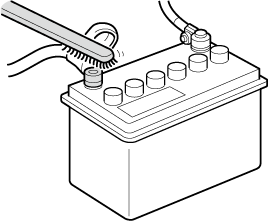
To get the best service from a battery:
-
Keep it securely mounted.
-
Keep the top clean and dry.
-
Keep terminals and connections clean, tight, and coated with petroleum jelly or terminal grease.
-
Rinse off spilled electrolyte immediately with a solution of water and baking soda.
-
If the vehicle will not be used for an extended time, disconnect the battery cables and charge the battery every 6 weeks.
Key Battery Replacement
If the buttons on the transmitter are inoperable and the operation indicator light does not flash, the battery may be dead.
Replace with a new battery before the transmitter becomes unusable.
-
Make sure the battery is installed correctly. Battery leakage could occur if it is not installed correctly.
-
When replacing the battery, be careful not to touch any of the internal circuitry and electrical terminals, bend the electrical terminals, or get dirt in the transmitter as the transmitter could be damaged.
-
There is the danger of explosion if the battery is not correctly replaced.
-
Dispose of used batteries according to the following instructions.
-
Insulate the plus and minus terminals of the battery using cellophane or equivalent tape.
-
Never disassemble.
-
Never throw the battery into fire or water.
-
Never deform or crush.
-
-
Replace only with the same type battery (CR2032 or equivalent).
The following conditions indicate that the battery power is low:
-
A message, “Low Key Fob Battery. Replace Battery” is displayed on the multi-information display when the ignition is switched OFF.
-
The system does not operate and the operation indicator light on the transmitter does not flash when the buttons are pressed.
-
The system's operational range is reduced.
Incorrect battery replacement operation may damage the key. Replacing the battery at an Authorized Mazda Dealer is recommended. If replacing the battery by yourself, follow the instruction.
Replacing the key battery
-
Remove the lower cover while sliding the knob in the direction of the arrow.
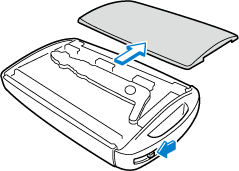
-
Press in the tab to unlock the upper cover.
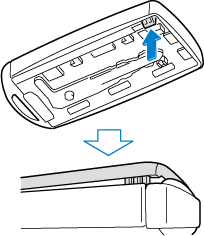
-
Insert a tape-wrapped flathead screwdriver into the gap and slide it in the direction of the arrow.

-
Twist the flathead screwdriver in the direction of the arrow and remove the upper cover.
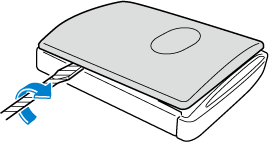
-
Remove the cap using the tape-wrapped flathead screwdriver.
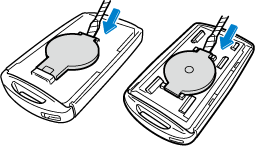
-
Remove the battery using tape-wrapped flathead screwdriver.
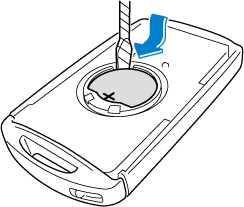
-
Insert a new battery into the transmitter so that the positive pole is facing up.
-
Install the cap.

-
Install the upper cover.
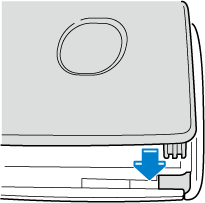
-
Insert the tabs of the lower cover into the slots of the transmitter and install the lower cover.
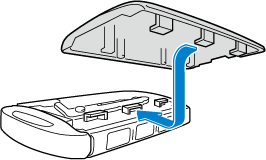
Tires
Tire Rotation
Rotate tires periodically:
Irregular tire wear is dangerous. To equalize tread wear for maintaining good performance in handling and braking, rotate the tires periodically or sooner if irregular wear develops.
Please refer to Scheduled maintenance for your tire rotation interval.
During rotation, inspect them for correct balance.
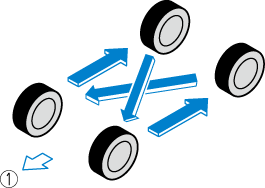
-
Forward
Do not include (TEMPORARY USE ONLY) spare tire in rotation.
Also, inspect them for uneven wear and damage. Abnormal wear is usually caused by one or a combination of the following:
-
Incorrect tire pressure
-
Improper wheel alignment
-
Out-of-balance wheel
-
Severe braking
After rotation, inflate all tire pressures to specification (Search) and inspect the lug nuts for tightness.
Rotate unidirectional tires and radial tires that have an asymmetrical tread pattern or studs only from front to rear, not from side to side. Tire performance will be reduced if rotated from side to side.
Temporary Spare Tire
Inspect the temporary spare tire at least monthly to make sure it is properly inflated and stored.
The temporary spare tire condition gradually deteriorates even if it has not been used.
The temporary spare tire is easier to handle because of its construction which is lighter and smaller than a conventional tire. This tire should be used only for an emergency and only for a short distance.
Use the temporary spare tire only until the conventional tire is repaired, which should be as soon as possible.
Refer to Tires (Search).
-
Do not use your temporary spare tire rim with a snow tire or a conventional tire. Neither will properly fit and could damage both tire and rim.
-
The temporary spare tire has a tread life of less than 5,000 km (3,000 miles). The tread life may be shorter depending on driving conditions.
-
The temporary spare tire is for limited use, however, if the tread wear solid-band indicator appears, replace the tire with the same type of temporary spare (Search).
Tires degrade over time, even when they are not being used on the road. It is recommended that tires generally be replaced when they are 6 years or older. Heat caused by hot climates or frequent high loading conditions can accelerate the aging process. You should replace the spare tire when you replace the other road tires due to the aging of the spare tire. The period in which the tire was manufactured (both week and year) is indicated by a 4-digit number.
Refer to Tire Labeling (Search).
Light Bulbs
Front
Type A
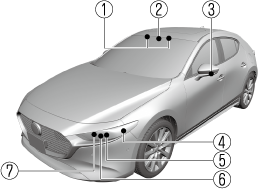
-
Vanity mirror lights (Some Models)
-
Overhead lights/ Front map lights
-
Side turn signal lights (Some Models)
-
Front side-marker lights
-
Parking lights
-
Headlights (High/Low beam)/ Daytime running lights
-
Front turn signal lights
Type B
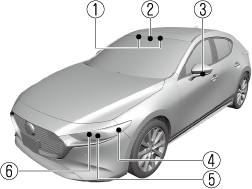
-
Vanity mirror lights (Some Models)
-
Overhead lights/ Front map lights
-
Side turn signal lights (Some Models)
-
Parking lights/Front side-marker lights
-
Headlights (High/Low beam)/ Daytime running lights
-
Front turn signal lights
Rear
4–Door
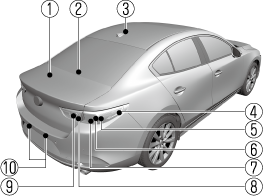
-
Trunk light
-
High-mount brake light
-
Overhead light (Rear)
-
Rear side-marker lights
-
Brake lights/Taillights (Some Models)
-
Rear turn signal lights
-
Brake lights/Taillights
-
Taillights (Some Models)
-
Reverse lights
-
License plate lights
5–Door
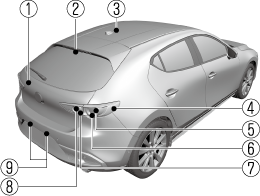
-
Luggage compartment light
-
High-mount brake light
-
Overhead light (Rear)
-
Rear side-marker lights
-
Rear turn signal lights
-
Brake lights/Taillights
-
Taillights (Some Models)
-
Reverse lights
-
License plate lights
When removing the lens or lamp unit using a flathead screwdriver, make sure that the flathead screwdriver does not contact the interior terminal. If the flathead screwdriver contacts the terminal, a short circuit may occur.
-
When replacing a bulb, contact an Authorized Mazda Dealer if necessary.
-
Use the protective cover and carton for the replacement bulb to dispose of the old bulb promptly and out of the reach of children.
-
For details regarding the installation positions of the interior lights, refer to the following:










































